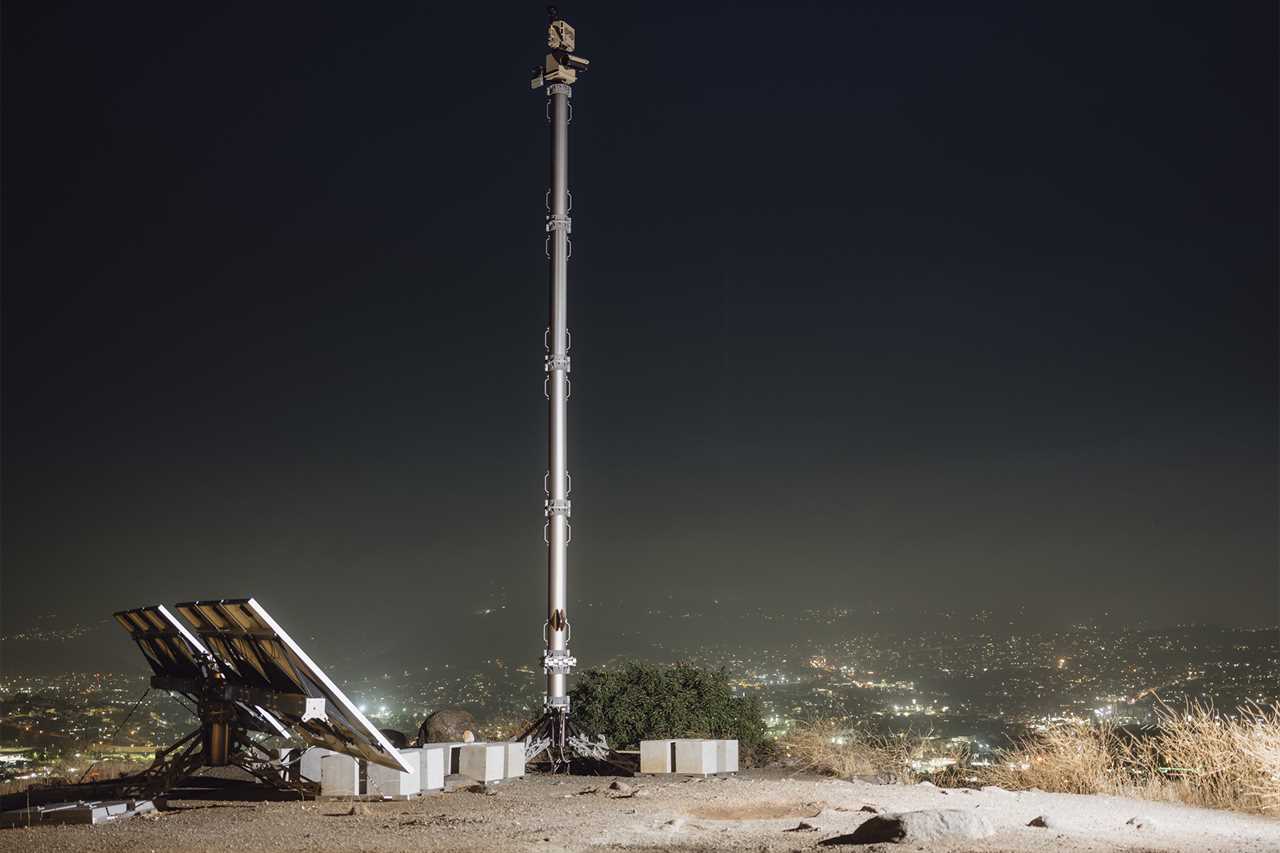
ORANGE COUNTY, Calif. — The break room is stocked with free sparkling water. The worktables are a lacquered, honey-blonde wood. And in the center of the gleaming workspace, under the scalding white ceiling of a two-story atrium, stood the solution to the southern border problem.
Its four mechanical legs spread over the polished cement. A metal mast rose in bolted sections and at the top, level with the second floor’s glass-walled offices, were two boxes. One controlled an array of radar and cameras. The other box, which from where I stood looked no larger than a child's lunch pail, connected through the ether to an artificial intelligence platform designed and run from these same offices. Working together, these devices would, after decades, finally deliver the long-promised “smart wall.”
It wasn’t the Pentagon that had developed this contraption, nor America’s storied defense companies. The sleek offices where I stood belonged to Anduril, a startup founded by Palmer Luckey, the precocious Silicon Valley sensation best known for inventing the Oculus VR gaming system. Anduril had left the tech cradle for Orange County, California’s Republican redoubt, where Luckey and his bed-headed employees were engineering the future of American security. The Sentry Tower was their debut. The system is, essentially, a camera on a pole. But what Anduril execs say set it apart from border surveillance towers of the past — and there have been a number — was that the tower could learn. The AI software, Chief Revenue Officer Matt Steckman told me, our necks still craned upwards, meant the tower would become increasingly more efficient at detecting migrants and smugglers.
“Think of it,” Steckman said, “as the most sophisticated security camera mankind has ever built.”
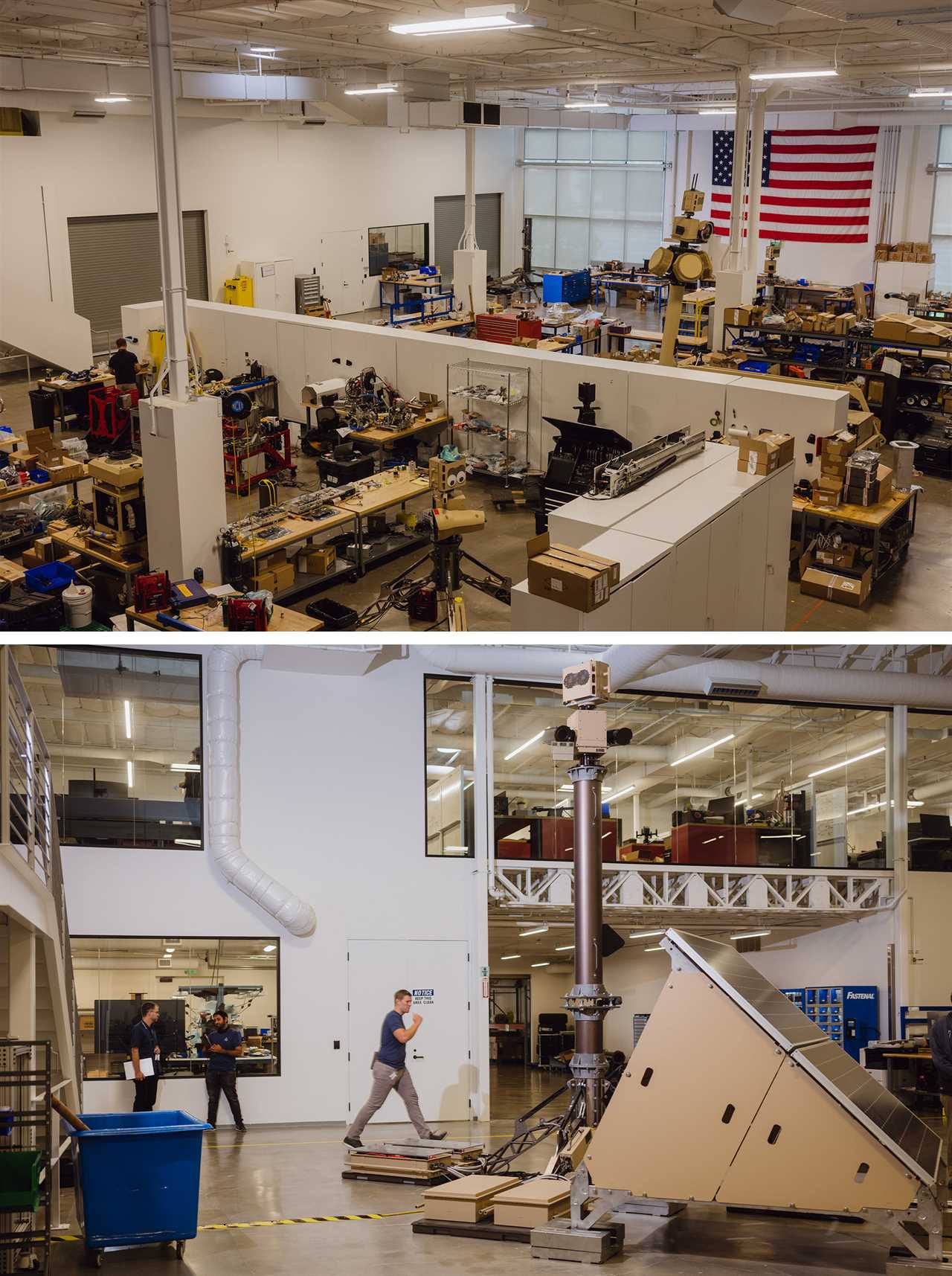
Every president since Bill Clinton has chased this technological dream. A physical wall is expensive. Yet it is still no match for a ladder. But a smart wall, a line of all-seeing surveillance towers aimed south, promises to seal the border through innovation. It would not only save money by reducing the number of agents needed to patrol the 2,000 miles of unforgiving terrain, it would also save lives. With a smart wall, migrants who found themselves lost in the deserts and mountains along the border would be spotted, captured and safely deported.
This is, at least, the vision Joe Biden is counting on.
On his first day in office, President Biden released his U.S. Citizenship Act of 2021 bill. Tucked between reforms for asylum, for visas, for the Dream Act, was a section titled “Deploying Smart Technology at the Southern Border.” Technology, the bill read, was the only way to “responsibly manage” and provide “situational awareness” on an otherwise vast, remote border. “I’m going to make sure that we have border protection,” Biden said last year, “but it’s going to be based on making sure that we use high-tech capacity to deal with it.”
At the moment, this high-tech capacity will come from Anduril, which has a contract worth hundreds of millions of dollars to place 200 sentry towers along the border in Texas, New Mexico and California. Luckey’s last enterprise was a success — he sold Oculus to Facebook for $2 billion — but the history of America’s quest for the smart wall has been, to say the least, underwhelming.
Over the past couple decades, the U.S. has sunk billions of dollars into towers 30-feet, even 160-feet tall, towers that are topped with radar, with night vision or thermal vision, and were built by the world’s mightiest defense contractors. Often, these systems ended with laughable results. They looked everywhere but down, so migrants and smugglers hid beneath them. The software, designed to detect humans, falsely dispatched agents to apprehend grazing cattle. And sometimes the hardware simply succumbed to the punishing sun, wind and rain of the Southwest.
Despite this record of failure, both Democrats and Republicans have clung to the dream. Even Donald Trump was smitten. As he publicly campaigned for his “big, beautiful wall,” his administration quietly signed the deal with Anduril. Only a smart wall, Democratic House Majority Whip James E. Clyburn wrote approvingly, “can result in immigration and border security practices that advance justice and mercy everywhere.”
Biden needs to get the border right. A majority of voters believed Trump’s wall was foolish. But the majority of voters under Biden now believe the border is in a state of crisis that requires immediate attention. So Biden has left in place Title 42, a 1944 public health law that Trump seized upon during the pandemic to turn away asylum seekers. He has half-heartedly fought Trump’s Remain in Mexico policy and, also like Trump, has pressured the Mexican government to deploy its military to catch migrants who cross north through the country to the U.S. These strategies have managed to both repel his progressive base and underwhelm those who believe he’s too soft on the border. Biden must appear, simultaneously, tough yet humane. So like presidents before him he has reached for the smart wall. But if history could speak, it might temper Biden’s hopes.
“This dream of constant surveillance,” says Geoff Alan Boyce, an Arizona-based director of the Earlham College Border Studies Program, “is informed by the technophiliacs in the security world who really believe that, essentially, the border can be approached like an engineering problem.” The companies who profit from government contracts, he said, “are perfectly happy to make all these operational promises of what they can deliver. But the history of technologies on the border is rather less impressive.”
Not only is Anduril’s system relatively unproven, after 15 years Customs and Border Protection, the parent agency of Border Patrol, hasn’t figured out how to measure what success looks like. Defense companies, Democrats and President Biden will also say a smart wall is a humane alternative to a physical wall. But those who’ve studied these systems believe the opposite: that they have helped to drive migrant deaths to historical highs. That outcome, critics say, is a feature of the smart wall, regardless of whether it’s equipped with the latest cameras, radar or artificial intelligence. In the end, the possibility remains that Anduril will deliver a product that’s all it’s cracked up to be — innovative and technologically sound. But this doesn’t mean it will achieve the ambitious results that policymakers and politicians have long demanded.
“They try to present what they do as very different from everything that has been done before,” says Iván Chaar López, who studies border technology at the University of Texas at Austin. But it’s “not that different from what all these older systems did.”
CBP says it uses a mix of walls, agents and technology in each area depending on the needs of Border Patrol. So “attributing a reduction in migration to a single asset would be an oversimplification,” the agency says. But if CBP can’t say for certain that surveillance towers deter migration, what has the government actually accomplished for all the money it has spent? To answer that larger question, I read through stale government reports on our efforts to secure the border with technology that reached decades back. I traveled through the deserts of Arizona, where past surveillance towers have operated since 2007, and I drove the border in Texas, New Mexico and California to speak with dozens of people in the U.S. and Mexico, trying to understand the impact of these systems on migrants. And I spent hours with the innovators at Anduril where the belief in Big Tech’s ability to defy history is palpable.
As I stood beside Steckman, the lights above gleaming on the sentry tower’s graphite colored mast, he turned to me. “The AI is controlling where it wants to look, and the AI can think and process at incomparable speeds to the human mind,” he said approvingly. “It’s constantly moving, and you’ll see that out in the field.”
Anduril was the second act for Palmer Luckey, who at 21 had sold Oculus for $2 billion to Facebook and stayed on until 2017 when he was forced out. Why he was forced out wasn’t clear. A gaming company accused him of stealing code for his VR. (A jury later exonerated him of the theft but determined he had violated his non-disclosure agreement and ordered him to pay $50 million for improper trademark use.) Around the same time as the suit, it was revealed he’d donated $10,000 to a far-right smear campaign against then-presidential candidate Hillary Clinton.
Jobless, the wunderkind known for dressing in Hawaiian shirts and sandals, hosted a meeting at his plush California home. Over greasy bags of Chick-fil-A, someone said, “You know what the United States really needs? Stark Industries from the ‘Iron Man’ movies.” And with that comic-book inspired concept, and seed money from billionaire conservative Peter Thiel, Luckey and a group of disaffected Silicon Valley techies devised Anduril, a futuristic defense company named after a sword in The Lord of the Rings.
“We are spending more than ever on defense technology, yet the pace of innovation has been slowing for decades,” Luckey told the New York Times. “We need a new kind of defense company, one that will save taxpayer dollars while creating superior technology to keep our troops and citizens safer.”

They floated ideas of American soldiers wielding lightsabers. Maybe even force fields. But they settled on the sentry tower, with the prototype assembled from, what seemed to be, a small utility pole and a camera topped with spikes to threaten the birds away. It was a concept in search of a market.
One of the first to take note was former Texas Rep. Will Hurd, a big border tech advocate. Hurd, a Republican, connected Anduril with a rancher who agreed to let Anduril test its system on his land near the Rio Grande. Then Hurd teamed up with fellow Texan and Democratic Rep. Henry Cuellar. Together, Hurd and Cuellar introduced the SMART Act, a bill to secure the southern border with technology that would only cost half-a-million dollars a mile, compared to Trump's $20-million-a-mile wall. Luckey was brought in to consult.
The SMART Act never left subcommittee, but Anduril worked a quick deal with Custom and Border Protection’s Silicon Valley office, a group geared for nimble acquisitions called INVNT.
“Three days after they incorporated, they met with the innovation team,” said a former CBP official who was granted anonymity to talk candidly about his work at INVNT. Anduril’s artificial intelligence impressed INVNT, the official says, because smart wall systems of the past relayed feeds to a command center, which meant three agents on 24-hour shifts were paid to stare at monitors. Artificial intelligence eliminated that need. It could sift the hours of footage in real time and alert an agent only when the system detected an intruder. By 2018, CBP’s INVNT office offered Anduril a trial run near San Diego. “It’s always about more tools in the toolkit,” the official says.
Anduril got a boost when Trump shut down the government in late 2018 in an effort to pressure Congress to divert $5 billion for his wall. Democrats held out, and demanded instead that the money buy “new cutting edge technology along the border.” On Jan. 25, Trump walked to a lectern in the Rose Garden and announced he’d reopened the government. “The walls we are building are not medieval walls. They are smart walls designed to meet the needs of frontline border agents,” Trump said. His border security vision, he said, mirroring the Democratic language, included “sensors, monitors and cutting-edge technology.”
Anduril was a low-risk investment. Unlike defense companies of past that bid for contracts then receive bundles of taxpayer dollars to engineer a concept into reality, Anduril finished the R&D on its own. In 2020, with its test phase complete in San Diego, Anduril inked its deal with Trump’s CBP. In a few years, Anduril had grown from an idea conjured over the waft of greasy chicken to a nascent defense company. It was a remarkable pace. Of course, it helps to have friends with influence.
The ultra-conservative billionaire Thiel had not only bestowed Anduril its seed money, he’d also served on Trump’s transition team. Thiel, the founder of PayPal, donates millions to America’s most virulent anti-immigrant politicians and PACs. Thiel’s influence is apparent throughout Anduril. A number of its executives hail from Palantir, Thiel’s AI-driven surveillance company that collects data on Americans and foreigners for agencies as varied as police departments, Immigration and Customs Enforcement, and the CIA. In fact, it was the CIA’s venture capital fund, In-Q-Tel, that initially funded Palantir. Steckman, my tour guide for Anduril’s headquarters, worked for Palantir, where he’d played a small role in a scandal to drum up dirt on journalist Glenn Greenwald.
The end of Trump’s presidency didn’t slow Anduril a beat. Far from it. Border technology companies have long favored Democrats, at least financially, and Anduril’s work aligned perfectly with Biden’s vision for securing the border. “President Biden hit the nail on the head,” the company wrote, “when he announced before a joint session of the Congress on April 28th that ‘high-tech capacity’ provides a viable path forward for border protection.” So, as the media focused on Biden’s calls to end Trump’s physical wall, with their newfound power Democrats asked for more taxpayer money to fund a smart wall. Meanwhile, sentry towers began to rise along the Texas border.
In October, I visited Anduril’s test site outside San Clemente, California, on a beautiful hilltop formerly used by defense contractor Northrop Grumman.
In the distance, two Anduril employees waited in an open field, half a mile away. Under the gazebo where Steckman and I stood, a man wearing a tactical watch spoke into the radio. “Up the hill,” he commanded. So, the employees walked up a trail. To our left, the 33-foot-tall Sentry Tower whirred to life.
The AI-powered radar and camera, capable of seeing 1.5 miles, panned across the valley. We watched a topographical map on a monitor, which Steckman referred to as the system’s “computer vision,” but which seemed to me a fairly regular software display on a fairly regular computer screen. Soon green boxes surrounded the two employees. Beneath each box was the artificial intelligence’s estimation of what it had detected: “PERSON 90%.”
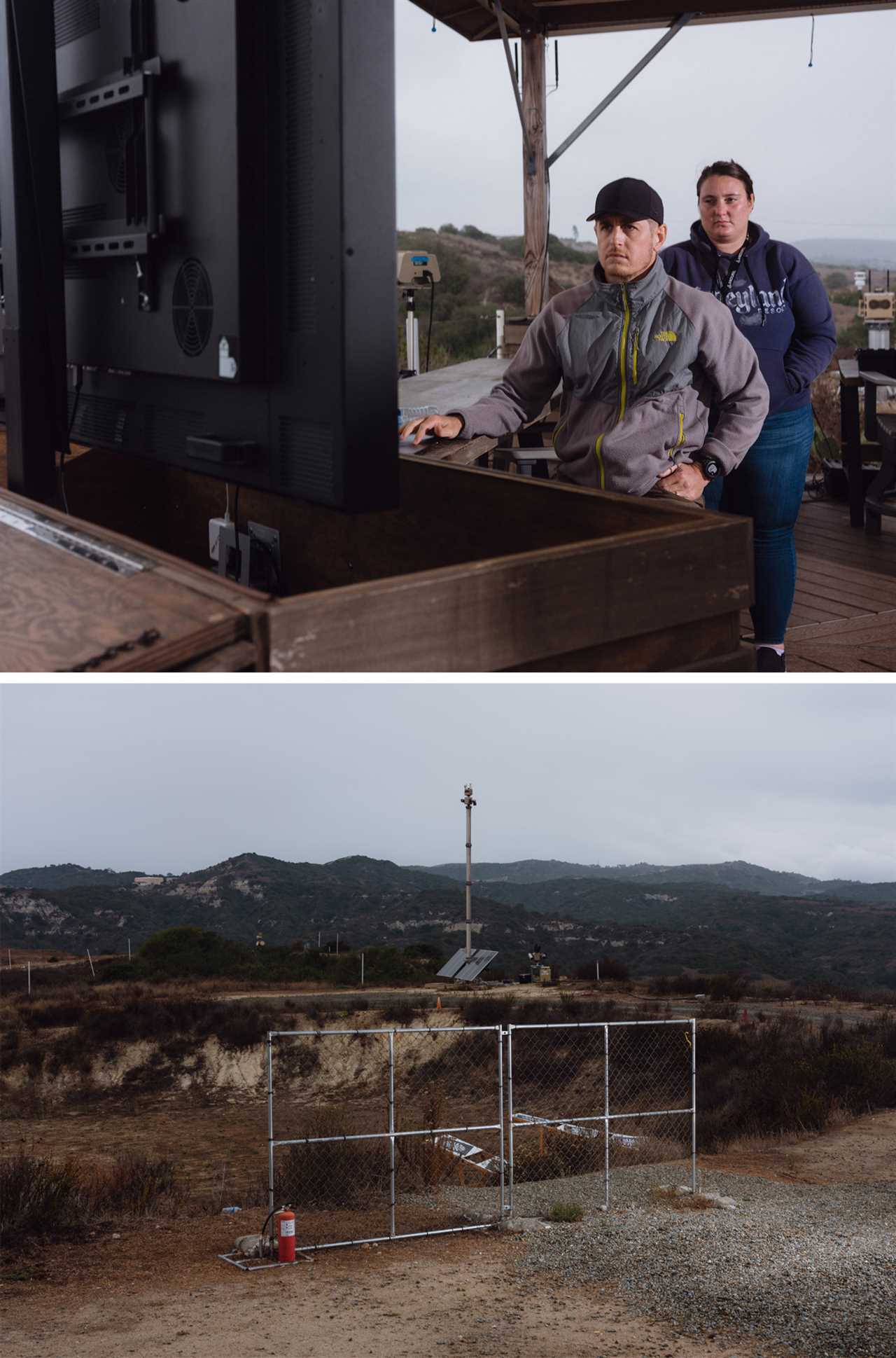
If this were the border, and the two employees were migrants, the software would alert nearby agents, and the agents would receive GPS coordinates on their smartphones. This was what set Anduril’s border surveillance system apart from previous systems: no middlemen. No longer would Border Patrol agents be forced to stare at a bank of screens like office building security guards monitoring closed-circuit cameras. As Steckman told me many times, there are tasks that are better left to computers.
CBP calls technology on the border a “force multiplier” because, in theory, it should reduce the number of agents on patrol. A surveillance tower is not much different than posting an agent on a hill with binoculars. Except, technology doesn’t need bathroom breaks. It doesn’t get tired or distracted. But a major difficulty earlier systems faced was the shoddy software, which ended up wasting a lot more time than they were worth because the towers constantly triggered false alarms.
“The only way to confirm the false alarm was for an agent to go out physically and figure out what the camera was picking up,” Geoff Boyce, the Earlham College border researcher, told me. “Nine times out of 10, it was a cow or a hiker.”
Anduril’s artificial intelligence has fixed this, the company claims, because it learns. “There’s this place along the border where there are a lot of bicyclists,” Steckman told me. The artificial intelligence kept alerting, so Anduril’s engineers spent a week training the system, then pushed out an update to the towers that taught it differentiate between migrant and biker. “That sort of responsiveness to the mission,” Steckman said, “is part of the reason we’ve been able to grow and accelerate so quickly.”

But Anduril also designed improvements to the sentry tower that, to anyone outside the legacy defense companies, might seem obvious. To install towers for previous systems required all the effort of erecting a suburb in the desert: Power lines or massive generators, roads, and communication infrastructure needed to be installed in the most isolated frontiers in the U.S. But Anduril’s sentry towers run on solar panels. A few trucks can carry it to a location and a crew can set one up in a couple hours. Other surveillance systems also used expensive, bespoke cameras and radar — “Gucci” sensors, as Steckman called them. Anduril buys its hardware off the shelf, which reduced the cost.
Under the gazebo, the man with the tactical watch called the employees back and the sentry tower tracked their movements down the hill. But this was hardly the most challenging terrain: The tower was set on a hill, and the land below was a field of grass no taller than a golf green. At the base of the cliff was a small forest. I asked Steckman if he’d send the two men into the trees. On the border, I reasoned, migrants and smugglers would likely use the environment to evade detection. “Well,” Steckman said, “they can hide but the system will just pick them up when they come out.”
That might be true in ideal conditions. Anduril has contracted with the U.S. government to monitor military bases and, recently, the United Kingdom’s Ministry of Defence. But any building or compound or campus is a defined area, with only so many entry routes. The border is a different animal. And to understand the challenges Anduril’s sentry tower will face you have to understand why its predecessors failed.
As an undergrad, still with a head full of hair, Boyce spent a semester abroad in Mexico while the U.S. bombed Iraq in 2003. When he returned to Arizona, he watched as the War on Terror turned inward on the American homeland, and the newly created Department of Homeland Security loosed scores of agents in white and green SUVs upon the desert, the highways and the border towns. “I just remember feeling awful, and helpless to do anything about what was happening,” Boyce remembers. So he volunteered with No More Deaths, a humanitarian group that placed water in the desert for migrants because, he says, “it felt like a tangible response to that moment in history.”
At first Boyce dropped gallon jugs along a remote network of roads near Buenos Aires National Wildlife Refuge, where migrants walked just beyond sight of the highway. But soon he saw work crews erecting large towers five, sometimes 12 miles back from the border. Every time Boyce returned to replenish the jugs, he found fewer had been taken. Soon none were touched. The migrants had vanished, or at least that is how it first appeared, and Boyce wondered where they’d gone to.
The towers Boyce noticed were part of SBInet, a DHS project that would string a virtual wall from San Diego to the Gulf of Mexico in Texas and was initially estimated to cost to taxpayers between $8 billion and $30 billion. Built by defense contractor Boeing, the towers would stand 100-feet tall. They were to be armed with the latest radar technology to scan the environment, and when custom-designed software detected a human — billed as early artificial intelligence — agents at a command center could zoom in with high-powered cameras to spot the intruder, then dispatch agents to grab the migrant.
Only two years into the program’s test phase, the Government Accountability Office issued a lengthy, troubling report on the system’s progress. The cameras, which Boeing promised would see for six miles, had trouble viewing half that distance. Deer, livestock, even tumbleweeds, set off the radar. So rather than a force multiplier, the command center that collected video feeds constantly dispatched agents to respond to false alarms. “Project 28,” the GAO wrote of the test phase, “resulted in a product that did not fully meet user needs and the project’s design will not be used as the basis for future SBInet development.” That was in 2008, but for another three years CBP pressed on.
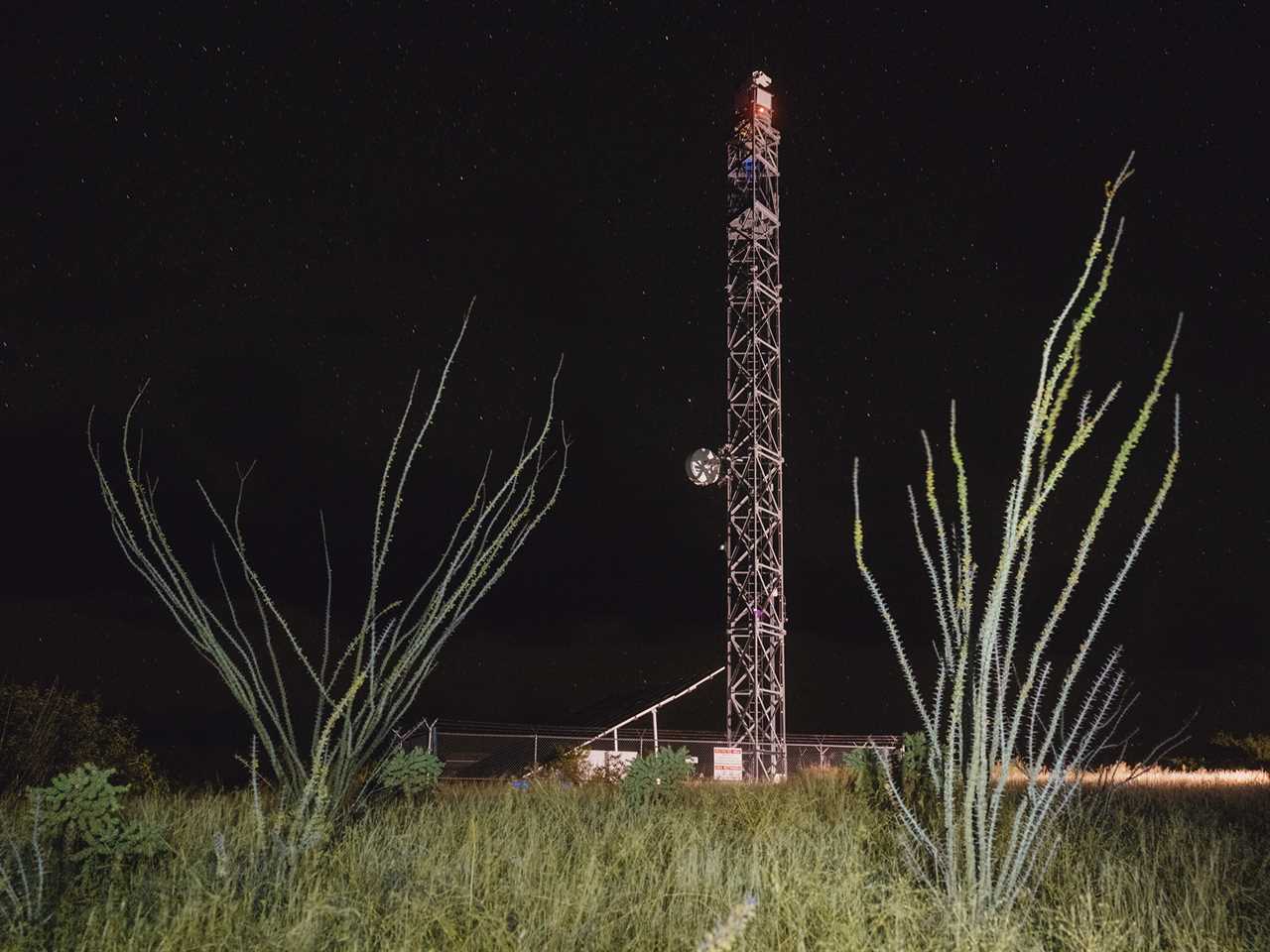
Even as Boeing and CBP worked to correct errors of the past, they encountered more from the landscape. The sun fried electrical circuits, and after each rain during the monsoon season a shimmer rose from the ground like a mirage that nearly blinded the cameras. “You get this really bad wave distortion,” an engineer had said. “Once it gets up to 110, 120 degrees it gets really hard to visualize a target, and you just can’t see much of anything.” But even if the technology worked, American hubris had overlooked an essential truth: Faced with an obstacle, humans will find a way around it. “If there’s any gap in the sensor network,” James A. Lewis, senior vice president at the Center for Strategic and International Studies, Lewis told me, “smugglers will find it.”
Smugglers and migrants did find a way around the towers, much more quickly than CBP could build them. Take, for example, the cameras. Matthew Longo, researcher and author of The Politics of Borders, told me a story that he said not only sums up SBInet’s failures, but that speaks to the predicament all border technology confronts. Boeing’s first cameras were fixed, pointed at one area. When smugglers caught onto this, they moved migrants through the blind spots. Then Boeing developed cameras that scanned the land. So, smugglers sent decoys to distract CBP while the main group scuttled past, out of sight. “So, then they created this new kind of camera that was 360-degree, super-fancy vision,” Longo says. “But it didn’t look down.” The towers became a place to hide safely, literally beneath CBP’s eyes. “This was three different versions, and each solution generated a new problem,” Longo laughs. “There is a constant adaptation between the tech and border crossers, and it quickly becomes an arms race to the bottom.”
At an end cost of more than $1 billion, SBInet covered only 53 miles — about $19 million a mile. Officials can’t say they weren’t warned. Decades earlier, the U.S. had commissioned a study on border security by scientists at Sandia National Laboratories in New Mexico. The conclusion of the three-volume report was unequivocal: “When this analysis was proposed, there was a belief that significant improvements in border control could be achieved by introducing new or improved technologies and that the application of these could lead to reduced manpower and significant control of the Southwest Border,” the authors wrote. “Those beliefs were, in our opinion, incorrect.” But faced with proof of that prediction, officials chose to bet again and again on the unproven promise of smart walls. In January 2011, the same month that the Obama administration quietly ended SBInet, the U.S. opened bids on another costly surveillance system that eventually went to the Israeli defense company, Elbit Systems.
Elbit promised to bring to the U.S. what it had accomplished on its own border. Elbit’s 80- to 160-foot Integrated Fixed Towers were “field-proven” on Israel’s West Bank. They were technologically superior, with infrared cameras that could see for 7.5 miles, and radar that scanned a 15-mile radius. But the initial $145 million contract soon ran into familiar problems. When Elbit delivered the system, a CBP test showed the “camera did not provide sufficient video quality and the IFT system did not enable the operator to consistently identify possible entries” — which, of course, was the entire goal.
Elbit seemed to have upgraded the detection software. And unlike SBInet, the towers didn’t continually break down. But to install the massive systems, CBP needed to clear roads in the desert and drill deep support pads, which required a mess of local, state and federal environmental surveys. The system hit delays, and the last of 65 towers in Arizona rose this year, having covered approximately 250 miles of border. Meanwhile, the number of Border Patrol agents deployed to the U.S.-Mexico border increased from 4,000 in 1993 to 17,000 in 2019 and Border Patrol’s budget jumped tenfold, from $363 million to $4.9 billion. CBP is now the largest law enforcement agency in the country. But all that money, those agents and the tech have done practically nothing to slow illegal immigration on the border.
I asked CBP how it measures the effectiveness of Anduril’s sentry tower, or any tower, along the border. If the intended goal of any surveillance system is to help deter migration, how does the agency measure this outcome? “U.S. Border Patrol leverages various methods to evaluate all technology solutions that are deployed, to include their impacts on the operating environment, holistically,” the agency wrote me. “Such measures of effectiveness may include system availability, system reliability, autonomous identification capability, cyber resilience, and survivability.”
But availability, reliability, survivability aren’t metrics of effectiveness. They’re measurements of sturdiness. In other words, the system might work exactly as it was designed but still not solve the most vexing problems on the border.
I’d asked Steckman a similar question. How does Anduril know that the sentry tower deters migration along the border, which after all is CBP’s goal?
“Unfortunately,” he said, “that’s uhm, that’s a CBP question.” I had seen Steckman address this question elsewhere, including in a local newspaper in Texas, where the company had recently deployed its sentry towers. He seemed to acknowledge the paradox.
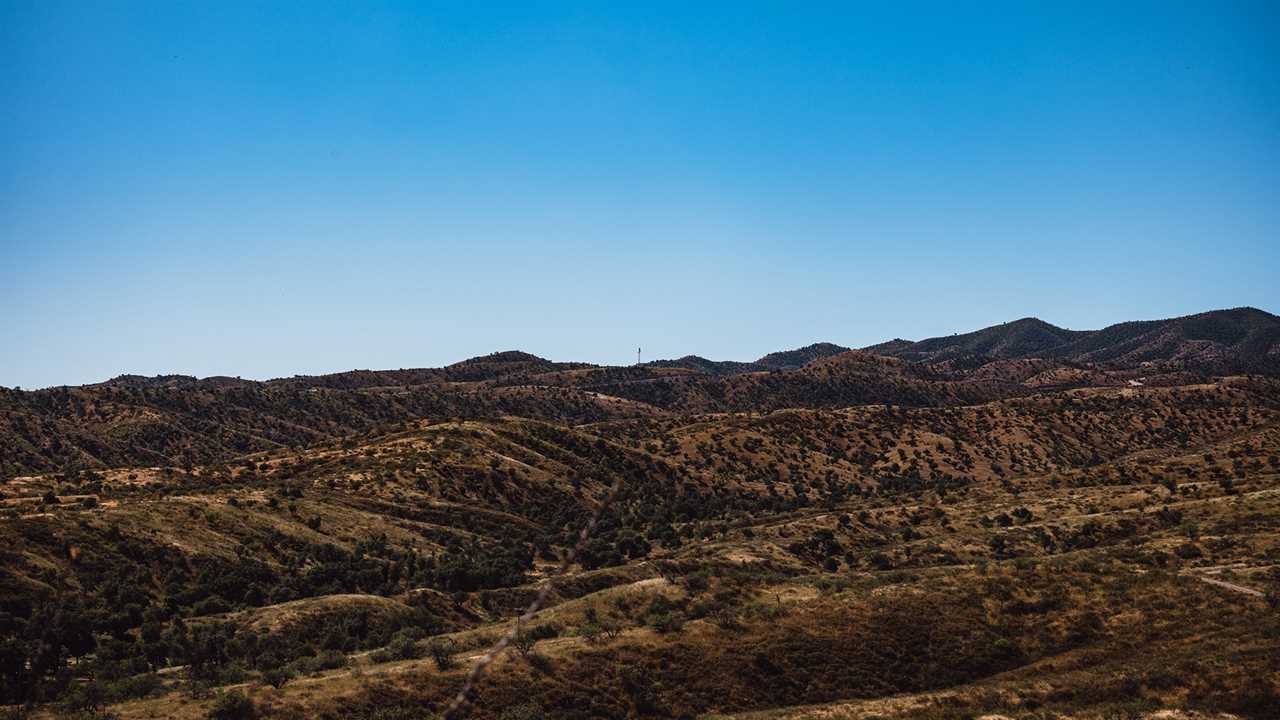
“You’ll see sort of a spike that’ll sort of run for a few weeks and then you’ll see detections going down,” he told the Big Bend Sentinel of resulting immigration patterns. “And you’ll see traffic sort of squirting to the east and west of the systems.”
This gets at a larger problem with technology. The GAO and the DHS Office of Inspector General have repeatedly asked CBP to develop metrics, some quantitative data, to show the systems help deter immigration. In a 2017 report, the GAO authors seemed exasperated, having to pose the same question they’d asked when CBP started placing surveillance towers on the border a decade before. “We recommended, among other things, that CBP analyze available data on apprehensions and seizures and technological assists … to determine the contribution of surveillance technologies to CBP’s border security efforts.”
For years, the agency’s top leaders have dismissed this line of questioning. Former CBP Assistant Commissioner Mark Borkowski, before a room of security industry leaders in 2013, had said, “One of the things the GAO said is, ‘You should measure the number of apprehensions where the technology contributed to the apprehension.’ That’s sort of a sensible thing, right? What about when the technology is a deterrence and there’s nothing to apprehend?”
So by that logic, the U.S. pays hundreds of millions for surveillance towers that deter migrants in a specific area but don’t actually stop them from crossing elsewhere. Almost like a scarecrow in a field. “CBP will say if we’re unable to show that the cameras are helping, it’s because they must be working,” Boyce says. “So, yeah, a 10-million-dollar scarecrow is a good characterization.”
Democrats frame the smart wall as a humane alternative to a physical wall, which they have often likened (despite their one-time support for them) as outdated and quasi-barbaric, “a 14th-century solution to a 21st-century problem,” as Rep. Cuellar put it. Trump played into this with get-tough rhetoric about the virtues of a physical barrier. While visiting the border he once remarked that his wall was designed to absorb heat, which would presumably burn the flesh of any migrant who attempted to climb it. “You can fry an egg on that wall,” Trump joked. A surveillance tower won’t burn anyone. Migrants can’t fall off of it. But the idea that it is any more humane is puzzling, especially because they have not slowed migration. The towers have only redirected it elsewhere.
This was the heart of the question Boyce had first asked when he noticed the untouched water jugs volunteers had stashed along the remote Arizona highways. Where had the migrants gone? After graduate school, as a post-doctoral student at the University of Arizona, that still unanswered question led him to collaborate with Sam Chambers, who’d come to the same university after studying the migratory patterns of elk. Their goal was simple: map the new routes the migrants were using and document the consequences.
In October, Chambers and I met in the Tumacacori Mountains, south of Tucson and west of Nogales, on the side of a country road. The worst of the summer heat was past, but the temperature was still 88 degrees. He pointed to an SBInet tower, 100 yards up a hill and through the chaparral. Then he started to climb. Not on a trail, just straight up — over the jagged rocks, yucca and through the mesquite.
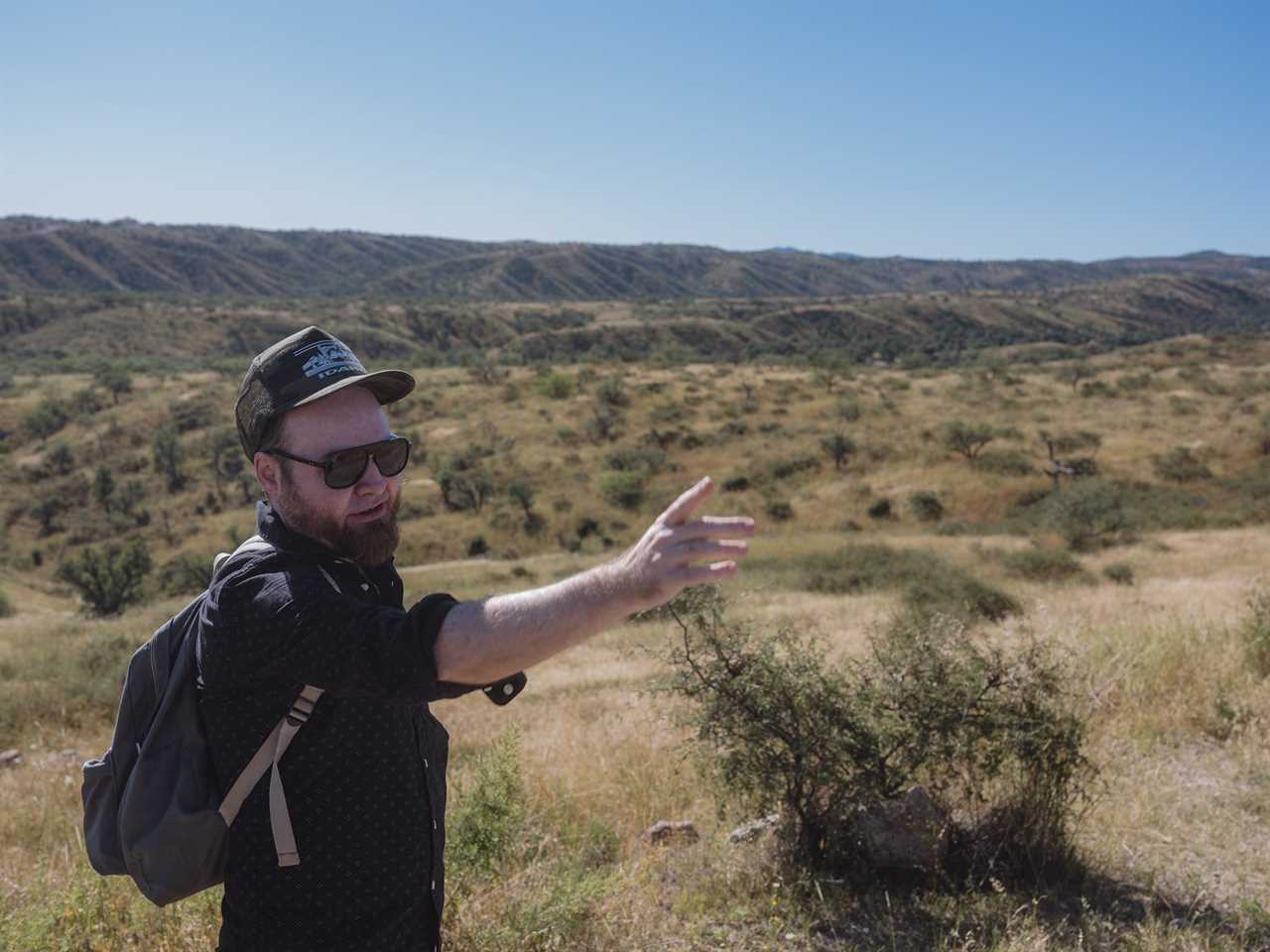
“Nobody had looked to see if surveillance towers were being evaded or not,” Chambers said as we walked. “You’re doubling, tripling the distance and exertion by adding these towers.”
The most reliable way to track the paths of migration was to document the locations of those who didn’t make it. So Chambers and Boyce collected data from the Pima County Office of the Medical Examiner, which had recorded the locations of every migrant body found in its district. That included SBInet territory. At the top of the hill, beneath the tower, Chambers swigged from a water bottle. We looked out across a network of ravines. The border was five miles away.
What was the tower doing so far back? I asked.
“This surveillance stuff is not about stopping everyone,” Chambers said. “It’s about manipulation.”
There was a time when Mexican vendors sold water jugs with a map glued to the side. The map displayed various mountain peaks, and migrants were directed to follow the promontories to highways where they would be picked up. Towers made that impossible. A 10-mile journey became a 20-mile march, and migrants increasingly relied on smugglers to guide them through arroyos, along mountainsides, weaving a path beyond sight of the towers. This is what Boyce and Chambers have termed CBP’s “corral apparatus,” an intentional strategy to funnel migrants into “a narrower corridor of movement” where they’re more likely to become isolated, confused, and where “physiological strain, suffering and mortality are likely to be greatest.” The very point of the surveillance tower placement, they contend, was to increase the difficulty of the journey.
“An initial strategy was to channel people into certain areas, to funnel them to a place where it’s easier to apprehend them,” James Lewis, who had advised on SBInet, told me. “That’s not good from a crosser perspective because they’re forced into more inhospitable areas, and the casualty rate goes up.”
This corralling has an official name, it’s called “prevention through deterrence.” The Clinton administration devised this strategy and CBP still practices it today — consciously or not. During the program’s first stages, in the mid-1990s, the U.S. raised walls near border cities with the intent to push migrants into the desert. Metrics like “a shift in flow” of migratory routes and “fee increase by smugglers” were signs of effectiveness. And deaths were an expected outcome. “Illegal entrants crossing through remote, uninhabited expanses of land and sea along the border,” the policy said, will “find themselves in mortal danger.” The government likely figured this would be an added deterrent, as stories of dead fathers and siblings filtered back through migrant networks. That is not what happened. Instead, as people left broken economies and rampant violence for the U.S., the death toll along the border soared and still the migrants came.

The report Chambers and Boyce wrote, which published this year, showed a map with dots to represent each migrant death recorded from 2004 to 2006 (before SBInet) and from 2007 to 2009 (after SBInet). Before the towers rose in the desert, the dead are dispersed, many in the lowlands where the firm and level ground makes for easier travel. But after the arrival of SBInet, the dots grow in number and begin to concentrate along the rocky western slopes and canyons of the Tumacacori Mountains.
“They’re having to walk longer distances,” Chambers said of the migrants, as he pointed below. It was a road, similar to one where Boyce had first laid water jugs some 20 years ago. The road followed a dry riverbed where trees provided enough cover from the car lights but was now exposed to the SBInet tower that we stood beneath. “We could stand here and sit in the shade. It’s livable,” he said. “But if you’re doing long distances you’re going to get hyperthermia. Your body is using up water, and once you can’t sweat there’s no way to cool yourself down.”
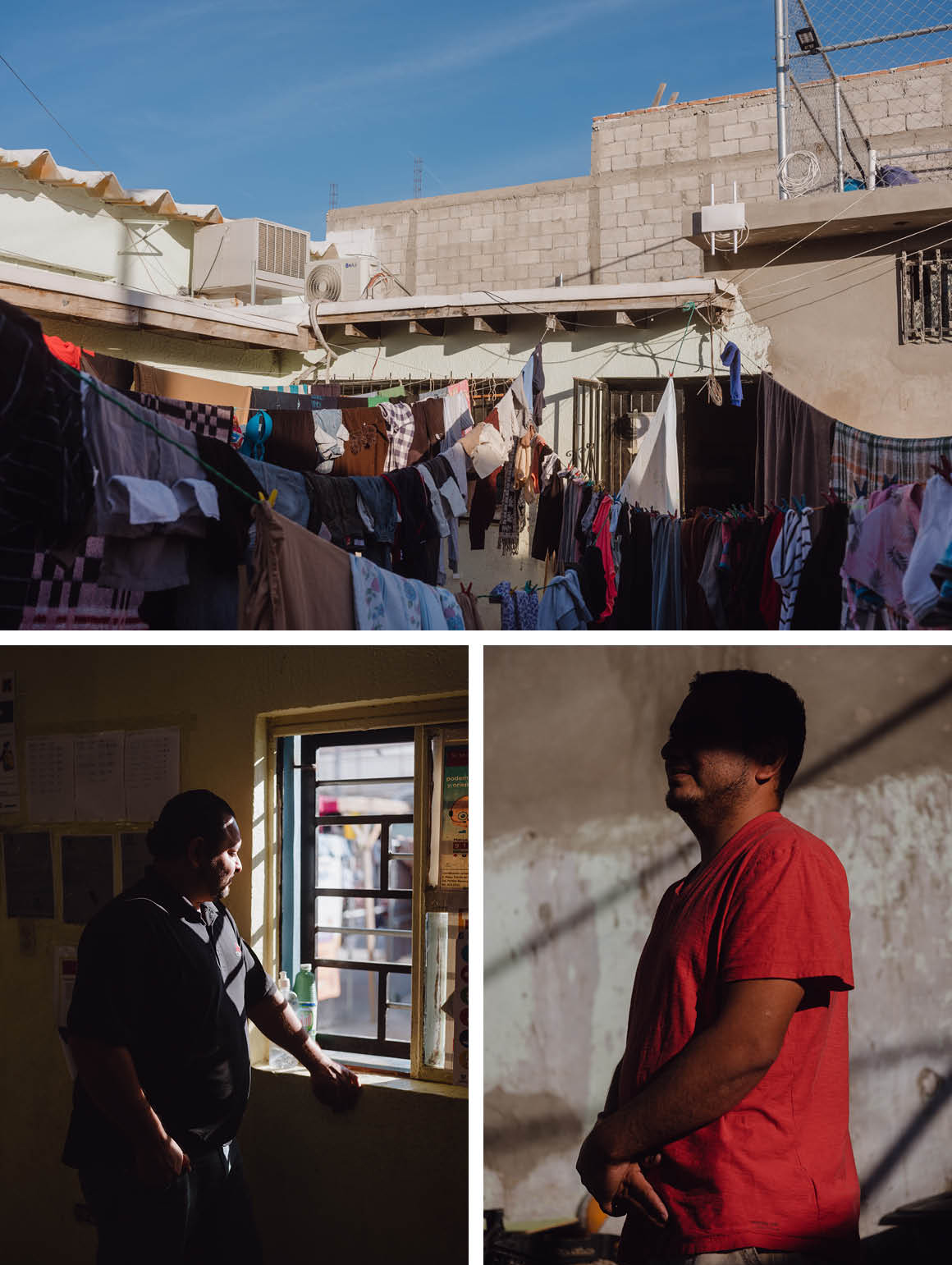
This year in Pima County alone, 210 migrant bodies have been found in the desert, on track for the most deaths of any year on record.
To the east and across the border, at a migrant shelter in Ciudad Juarez, I met with a Honduran man named Manuel. He’d left his country two years ago to seek asylum in the U.S., but since Trump had made gaining asylum nearly impossible through the Remain in Mexico policy, he decided to cross illegally through the desert near Lukeville, Arizona.
I showed him pictures on my phone of Elbit’s surveillance towers in that area and he recognized them. “We had to walk far out of the way,” he said. “The man I was with said the towers can see your body heat.”
Border Patrol came and scattered the group and Manuel was lost with his 16-year-old boy. For three days and nights, without food or water, Manuel believed he and his son would die. Luckily, they were saved by a humanitarian group that makes long treks into the desert to search for the bodies of migrants who were less fortunate. Because it’s illegal to drive anywhere with a migrant who crossed illegally, the aid group called Border Patrol, and Manuel and his boy are now stuck in Mexico, though glad to be alive.
Anduril’s system soon will cover much of the border. And I wanted to see a sentry tower, as it were, in the wild. Both CBP and Border Patrol declined my request to observe how they use the system. Neither the agencies nor Anduril would tell me exactly where they’d placed the towers. So after meeting with Chambers, I drove west from Arizona on Interstate 8 toward San Diego, where the Sentry Tower has been tested for more than two years. At California’s State Route 94, I turned south, stopping often with binoculars to scan the hillsides. As the sun set, I spotted a sentry tower on a hill that overlooked the Mexican border town of Tecate, set about a mile back.
The path to the tower circled the hill, and the rental car nearly bottomed out over the rutted road. It was dark, chilly, and a thick fog descended. As I stepped out of the car to stare at the city lights across the border, the sentry tower panned toward me and paused. Walls run from here nearly to the California coast, and I could see where CBP had blasted and dug, at great cost and almost impossible angles through the mountains to lay a foundation for the wall. The sentry tower, by contrast, whirred happily the hill’s dirt crest, its legs stretched out and the solar panels aimed south.
To the west of the hill a series of ravines rose and fell, much like those Chambers had shown me in Arizona. It was easy to imagine migrants crawling over the damp rocks, hiding on the other side of the canyon to evade the tower. Maybe, sometime in the future researchers will create a map of the sentry tower’s toll. But there might be hints of it already. Much farther to the west, in the Pacific Ocean, migrants are now taking to the sea in increasing numbers, where they cross the waters at night in fiberglass fishing skiffs. Sometimes the skiffs crash. The migrants are thrown into the dark sea and in the morning the waves push the splintered wreckage of the boats to land.
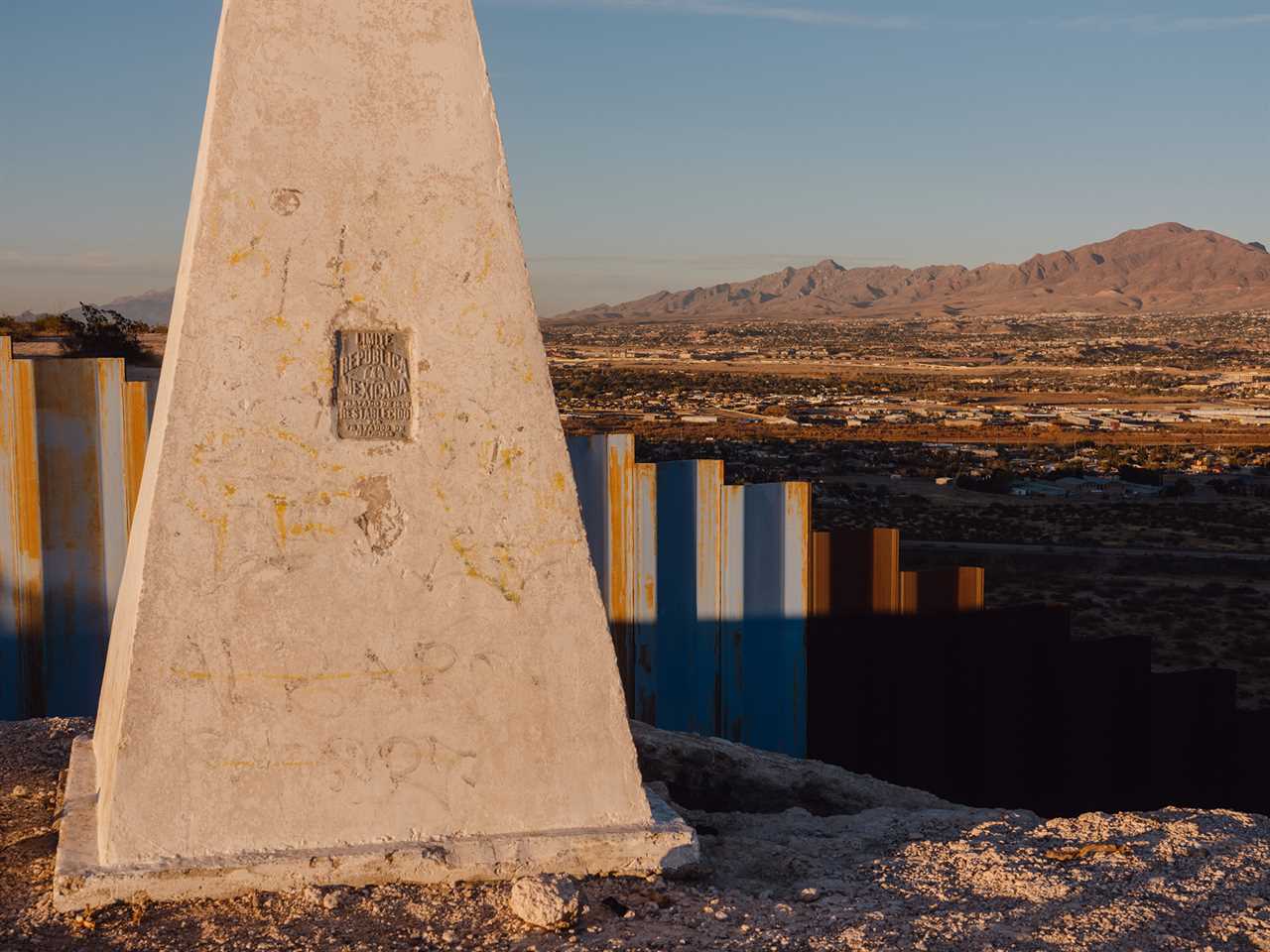
After half an hour, a Border Patrol agent parked beside my car to ask what I was doing. He’d seen me from the sentry tower’s camera, he said. He lit a cigarette. As we talked about the tower, he said smugglers from the other side have started to shine laser pens at the camera to blind it. He took a drag and, as he exhaled, he said, “They’re always coming up with something new.”
----------------------------------------
By: J. Weston Phippen
Title: The Long, Frustrating Quest for a ‘Smart Wall’
Sourced From: www.politico.com/news/magazine/2021/12/10/us-mexico-border-smart-wall-politics-artificial-intelligence-523918
Published Date: Fri, 10 Dec 2021 04:30:04 EST






